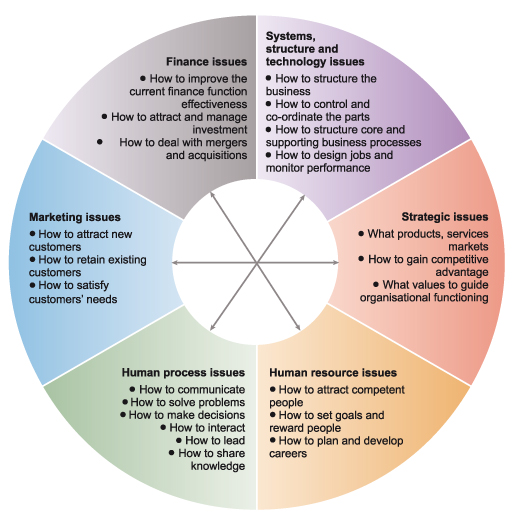3.2 Relating your work problem or change to key function areas
When scanning an organisation for possible work problems or changes, it is important to be alert to the impact of a specific starting point on other related aspects of management. A work problem at a specific functional level could also have cross-functional impact; that is, strategic implications in multiple functions within your organisation of interest.
Based on Cummings and Worley's (2004) four basic sets of organisational issues, six key function areas where change, development or innovation can be desirable are:
- strategic
- techno-structural
- human resources
- human process
- marketing
- finance.
These are illustrated, in modified and updated form, in Figure 6. When you are considering addressing a work problem or change in one of these six areas, you should think about which related issues, improvements, strategical implications, or questions emerge in any of the other five areas.
Look at Figure 6 as an example, illustrating different function areas within an organisation, and presenting questions and issues relating to the individual function area. Now review the main project topic, the questions and sub-questions you produced in Activity 3 and map them to the diagram below, identifying in which of the six areas your initial ideas and questions are.
Look at each area under which you have put your sub-questions. Are there any further aspects or changes in relation to each area that you would like to add?
Remember that you should aim to keep the problem and questions manageable, so only add more if you think you have missed important elements or to help you explore the problem or sub-questions you have already identified. You also need to be aware of various possibilities in terms of how narrowly or broadly you may have to define the set of problems or changes you are going to work on.
Activity 4 Developing your work problem or change into a clear statement
Now follow the suggested steps below and develop a clear statement of the work problem or change for your chosen context. This writing exercise is designed to help you develop a specific work problem or change statement.
Go through the three steps suggested below.
Step 1: Describe in two or three sentences the opportunity or change that you have identified.
Step 2: Look at every describing word (and question as below) and define each that you feel are necessary. Note that this is an iterative process, and you will need to look at the literature and relevant theory later.
What opportunities are you trying to find out? or What changes are you paying attention to?
Who are the target audience that you are interested in and report to?
Where does your project take place?
When are you starting and for how long?
Why is it valuable to study this opportunity or change (think about its strategical implications)?
Step 3: Rewrite your statement developed in Step 1, taking into account all the decisions you made in Step 2.

